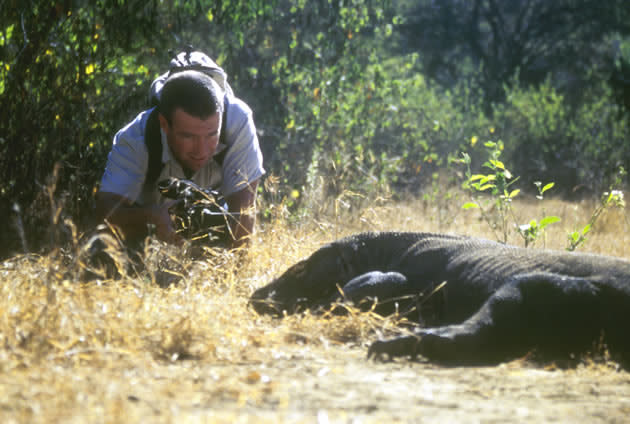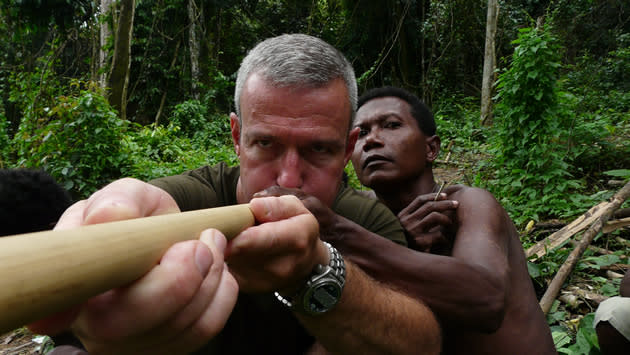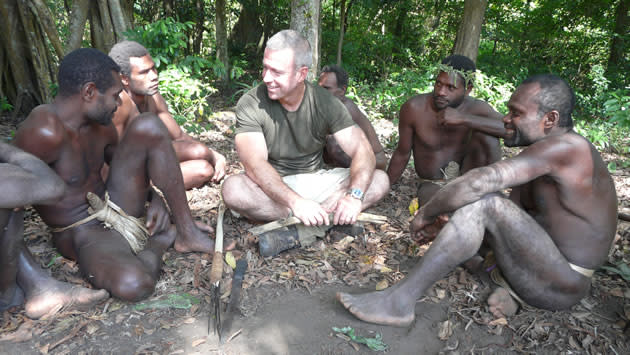Tourism and tribes keep host Hayden Turner on his toes

A rhinoceros charged him in Africa. An elephant dragged his tent in Malaysia. A minefield behind a zoo in Afghanistan he unwittingly walked into nearly blew him up.
Despite the many close shaves he's had in his life, nature show host Hayden Turner professes his love for the wild, for nature and for animals of all shapes and sizes.
He organises his own luxury safari tour trips to various parts of Africa, but has himself been to more than 35 other countries. Having helmed various kinds of television programmes, he has test-driven Lamborghinis, and shot and produced his own wildlife video segments.
It surprises one to learn, therefore, how passionate he is about wildlife conservation, and his belief that tourism does not run counter to this aim, but in fact, is "a massive part" of it.
"The tourism dollar funds an incredible amount of conservation projects in Africa and all over the world," says the 45-year-old, in a one-on-one interview with Yahoo! Singapore.
"The revenue that has come from the tourism dollar has been extraordinary, and has given rise to a massive number of jobs," he adds.
Turner explains that his brand of tourism is typified as "non-consumptive", where he simply takes people into the wild to see animals in their environment.
"The communities that we are then exposed to then understand that the animals and the wildlife they surround is valuable, so they have the tendency to protect it more, rather than wiping it out," he says, adding that the major companies involved in Africa's tourism industry exercise greater corporate social responsibility by contributing parts of their revenue into conservation programs there.
He argues that tourism is what gives things in the wild so much value, because it is only when people see indigenous communities and the wild for themselves that they appreciate it and want to protect it.
"From my experience, I've seen people who have had a close encounter with wildlife on a much more personal level when I've taken them come back advocates of conservation much, much more than they were before they left," he says. "It's touched their heart, their soul and their spirit, and they want to come back and share that with as many people as they possibly can."
Appreciating animals from a distance
Unlike the close interaction that the likes of the late Steve Irwin had with crocodiles, Turner believes in appreciating wild animals from a respectable distance.
From years of experience with seasoned professional African trail guides, he speaks of an "invisible barrier" distance, that he says varies between different animals, but is largely measured by observing the animals' signals and changes in behaviour.
"There is something deep in my heart that loves the danger... of knowing that an animal has the ability to take your life --but you haven't pushed it to do that, you've been able to observe it in a natural way, and you've walked away from it safely and given the animal respect. There's something very rewarding about that," he says.
"That's been a really strong part of my existence on the planet about the respect of giving other animals space, and watching them, observing them from afar... and teaching people how to do that," he adds.
His greatest challenge yet -- hunter-gatherer tribes
The former zookeeper ventures into territory unfamiliar even to him, however, in a series titled "Man Hunt" for which Turner spends between two and three weeks with four hunter-gatherer communities each, learning first hand how they hunt to survive.
This latest series, he admits, is among the most dangerous things he's ever hosted -- and that's saying something, for someone who has worked with zoos in Afghanistan and gotten into dangerous situations with wildlife.
To prepare for it, Turner says he trained at the gym on a daily basis over a period of between three to six months to boost fitness and his health.
"I spend a lot of time in the bush (where hunter-gatherer tribes frequently inhabit), but I was more concerned I was going to get internally sick from a virus, or something I had not been exposed to and I wouldn't have the strength to deal with internally, but I didn't get sick once on this whole series," he says, adding that he ironically fell ill several days after returning home, having contracted the flu on the plane.
Visually, Turner says these tribes were not as removed from the developed world as one might think, with most of them wearing shorts and T-shirts as their regular outfits, and not traditional costumes made of leaves and wood, for instance.
"But it's the 20,000 years of information inside their heads that I was trying to get," he says. "I was trying to get information about what the environment means to them, and really on a purely selfish level, I wanted to learn from these guys. I wanted to learn about animal behaviour, I wanted to learn how to watch and get closer, more safely, so I could take a better photo," he adds with a grin.
Hayden's top 10 tips for a good first-time safari experience
We also asked Turner for his take on the top 10 things a rookie wildlife explorer should do before embarking on his or her first journey into the wild:
Do your homework. Read as much as you can about where you're going online, or on publications.
Try not to bargain so hard with a local to the point where you begrudge him or her.
Respect cultures, religions and customs (see point 1).
Don't buy endangered species of plants and animals as souvenirs (and you'll know what falls under these categories by doing your homework).
Pack light, when possible.
Bring a fleece along even in hot countries, because once the sun goes down it can get quite cold.
Pack light-coloured, comfortable clothes that can blend into the landscape of the place you are visiting.
Essentials to bring: insect repellent, a good first-aid kit, sunscreen, a sun hat, sunglasses and binoculars.
Bring a sense of humour, a relaxed disposition and a pocket full of smiles -- they go a long way.
A tip on camera equipment for photography enthusiasts: for digital SLRs, a 7200mm lens will generally get you great wildlife shots.
Catch Hayden Turner in his last two episodes on the series Man Hunt, showing on the National Geographic Channel (Starhub TV Channel 411) on Friday, 25 Nov, and the final episode next Friday, 2 Dec, both at 9pm.




